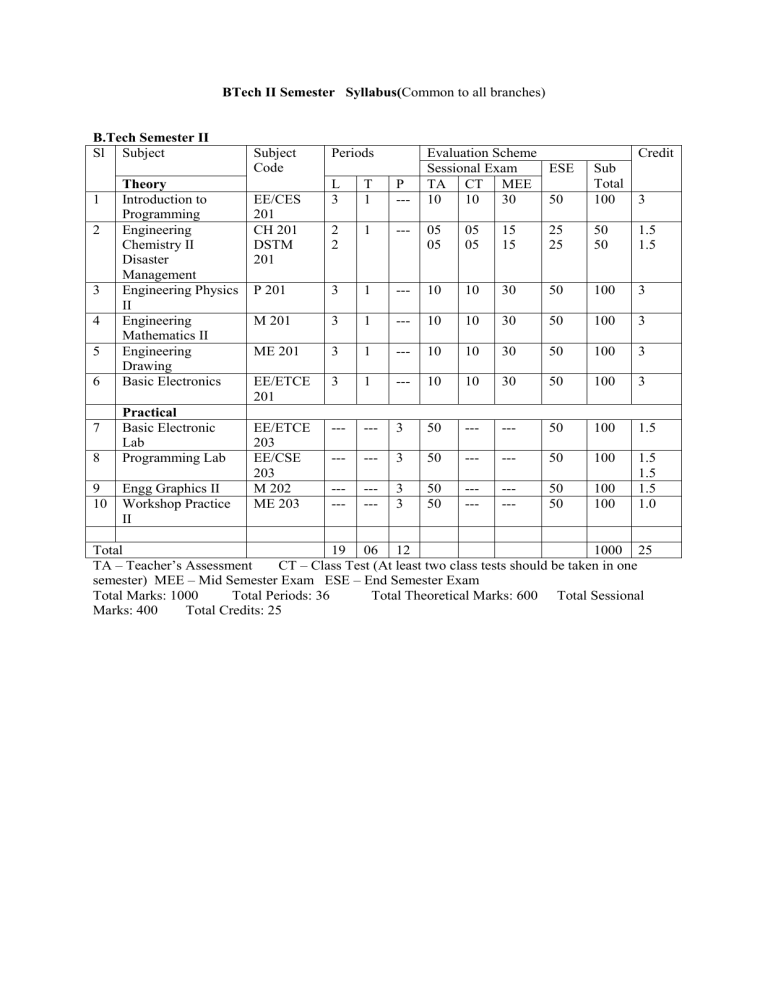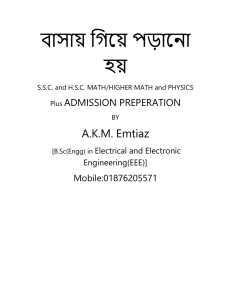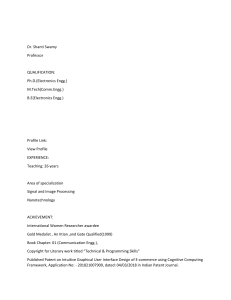
BTech II Semester Syllabus(Common to all branches) B.Tech Semester II Sl Subject 1 2 3 4 5 6 7 8 9 10 Theory Introduction to Programming Engineering Chemistry II Disaster Management Engineering Physics II Engineering Mathematics II Engineering Drawing Basic Electronics Practical Basic Electronic Lab Programming Lab Engg Graphics II Workshop Practice II Subject Code Periods Evaluation Scheme Sessional Exam ESE TA CT MEE 10 10 30 50 Sub Total 100 Credit 3 L 3 T 1 P --- 2 2 1 --- 05 05 05 05 15 15 25 25 50 50 1.5 1.5 P 201 3 1 --- 10 10 30 50 100 3 M 201 3 1 --- 10 10 30 50 100 3 ME 201 3 1 --- 10 10 30 50 100 3 EE/ETCE 201 3 1 --- 10 10 30 50 100 3 EE/ETCE 203 EE/CSE 203 M 202 ME 203 --- --- 3 50 --- --- 50 100 1.5 --- --- 3 50 --- --- 50 100 ----- ----- 3 3 50 50 ----- ----- 50 50 100 100 1.5 1.5 1.5 1.0 EE/CES 201 CH 201 DSTM 201 Total 19 06 12 1000 25 TA – Teacher’s Assessment CT – Class Test (At least two class tests should be taken in one semester) MEE – Mid Semester Exam ESE – End Semester Exam Total Marks: 1000 Total Periods: 36 Total Theoretical Marks: 600 Total Sessional Marks: 400 Total Credits: 25 INTRODUCTIONN TO PROGRAMMING (CSE 201) BASICS OF COMPUTERS: Computer fundamentals: Bits and Bytes, CPU, Memory, Input and output devices, I/O devices, Operating systems, Application softwar’s. Number system - Decimal, Binary, Octal, Hexadecimal. Need for high level languages, Program design using flow charts C language Preliminaries C character set, identifiers and keywords, data types, declarations, expressions, statements and symbolic constants Pre-processor commands: #include, #define, #ifdef Input-output: getch, putchar, scanf, printf, gets, puts Operators and expressions: Arithmetic, unary, assignment, logical, conditional and bitwise operators Control statements: if else, for, while, do while, switch, break, continue, nested loops Storage types: Automatic, external, register and static variables Functions: Defining and accessing, passing arguments, function prototypes, recursion, library functions, static function Arrays: Defining and processing, passing arrays to a function, multi-dimensional arrays Pointer: Basic concepts, malloc, pointers and arrays, simple singly linked list examples References 1. Learn C in three days, Sam Abolrous, BPB Publishers. 2. The C Programming Language, Ritchie and Kernighan, PHI. 3. Programming with C, Gottfried, TMH. 4. C How to Program, Deitel, PHI. 5. Foundations of Computing, PK Sinha and Priti Sinha, BPB Publishers. Engineering Chemistry-II CH – 201 (a) Cement:Introduction, classification; Portland Cement- definition, raw materials, manufacture, ideal composition and physical requirement according to I.S code, chemical constitution of the finished product, setting and hardening, heat of hydration; Special Cements- high-alumina, white portland, water-proof cements etc. (b) Refractories:Definition, objective of using, classification based on chemical nature; Properties- refractoriness, strength, dimensional stability, chemical inertness, thermal expansion, thermal conductivity, porosity, spalling, electrical conductivity etc. and interrelations between them; selection of good refractory; Common Refractory Bricks- silica, fireclay, high-alumina, magnesite and zirconia bricks, properties and uses. (c) Corrosion:Introduction, definition, classification; Dry Corrosion- factors effecting dry corrosion, mechanism, types, oxidation corrosion, Pilling-Bedworth rule, corrosion by other gases, hydrogen related corrosion, liquid metal corrosion; Wet Corrosion- types, chemical corrosion, factors affecting chemical corrosion, mechanism of wet corrosion- electrochemical mechanism, evolution of H2 and absorption of O2 types; Differential aeration theory, passivity, pitting, waterline and stress corrosion; Corrosion Control- purification, alloying, application of protective coatings, cathodic protection etc. (d) Lubricants:Introduction; Mechanism- thick-film, thin-film and extreme pressure lubrication; Classification of Lubricants- lubricating oils, greases and solid lubricants, their properties, use and additives required (e.g., anti-oxidants, corrosion preventers etc.); Properties of Lubricatiing Oils- viscosity, flash and fire-point, cloud and pour point, oiliness, carbon residue, aniline point etc. ; Cutting fluids. (e) Thermochemistry:Different types of energy and other definitions; Endothermic/ Exothermic Reactions and Energy Diagrams; thermochemistry stoichiometry, enthalpy, standard enthalpy of formation and reaction, Hess’s Law, heat of solution, heat of neutralization. References 1. PC Jain and Monika Jain, Engg Chemistry, Dhanpat Rai, New Delhi 2. Dara, A text Book of Engg Chemistry, S Chand & Co Disaster Management, Theory (DSTM-201) Elements of Engineering Seismology :- Earthquake Occurrence in the world, causes of Earthquake, Plate tectonics, Earthquake mechanism, seismic zoning map of India and its use. Earthquake phenomenon :- Focus, epicenter, seismic waves, magnitude, intensity scale its co-relation with ground acceleration. Guide lines on construction Earthquake resistant Houses, Seismic Hazard assessment and do's for protection of life and property during disaster. Land slide :- Geo-technical aspect of landslides and control of Landslide Hazard. Flood :- Flood Control as a measure of Disaster management and Mitigation. Cyclone and Fire :- Cyclone Disaster Mitigation and ensuring wind and fire hazard safety during disaster. References I. Narayan, Disaster Management, APH Publishing Corporation II. Murthy, Disaster Management, Deep & Deep III. Nijuj Kumar, Disaster Management, Alfa Publication SUB: ENGINEERING PHYSICS-II (P201) 2nd SEMESTER 1. Modern Physics: 16L Particle properties of wave: Planck’s hypothesis, Photoelectric effect, Compton Effect. Wave properties of particle: De Broglie wave as mater waves, Davison-Germer experiment, Heisenberg’s uncertainty principle and its application. Quantum Mechanics: Interpretation of wave function, Schrödinger equation (time dependent and time independent), particle in a box, Eigen values and Eigen function. Nuclear structure, atomic masses, mass spectrograph, particle accelerator (Betatron, Cyclotron, Synchrocyclotron), Nuclear reactors. Reference frames, Lorentz transformation, postulates of relativity, relativistic mass and massenergy relation. 2. Statistical Mechanics: 6L Concept of phase space, macro and micro states, statistical distributions, M-B, B-E and F-D statistics (no derivations) and their simple applications, Planck’s radiation law, Fermi energy, electron distribution in metal. 3. Solid State Physics and Nanotechnology (Introduction): 6L Crystallography: Crystalline and amorphous solids, crystal structure, Bravais Lattice, Packing Fraction, Crystallographic planes and miller indices, Inter-planer spacing (cubic system only), Bragg’s diffraction, Crystal structure analysis, Defects and disorders. Nanotechnology: Nanoscience: Nanomaterials and types: Quantum Dots, Quantum wires, Quantum wells, Nanocomposites, Properties. 4. Plasma Physics (Introduction) 6L Definition of plasma and occurrence, concept of temperature, Debye shielding, criteria for plasmas; Single particle motions in - uniform and non-uniform electric and magnetic fields, time varying electric and magnetic fields, confinement of plasma (magnetic and LASER), applications of plasma physics (Fusion, Industrial). 5. Laser and Optical Fiber: 6L Spontaneous and stimulated emission, Einstein’s A-B coefficient, meta-stable state, population inversion, basic principle of laser (three and four level), optical cavity and resonator, Ruby and HeNe laser. Propagation of light in fiber, step and graded index fiber, numerical aperture, attenuation in optical fiber, introduction of optical window, application of laser and optical fiber. Suggested Books Essential Reading: 1. Introduction to Unmagnetized Plasmas, Chanchal Uberoi, PHI Pub. 2. B.K. Agarwal, Elements of Statistical Mechanics 3. K. Huang, Statistical Mechanics 4. D.C. Tayal, Nuclear Physics, 4th edition, Himalaya House, Bombay (1980). 5. Kittel, Introduction solid State Physics, Willy Eastern Limited 6. Quantum Mechanics, A.K.Ghatak and S.Lokanathan 7. Nanotechnology: a gentle introduction to the next big idea, Mark A. Ratner & Daniel Ratner, PHI Pub. 8. Engineering Physics Vol-I & II ,Author- S. Bhattacharya Tata Mc Graw Hill, Supplementary Reading: 1. B.B. Laud : Fundamentals of Statistical Mechanics 2. Quantum Physics of Atoms, Molecules, Solids, Nuclei and Particles, R. Eisberg and Resnick, Wiley India Pvt. Ltd. 3. Quantum mechanics – Leonard I. Schiff 4. Relativity, R. Resnick, Wiley Eastern Pvt. Ltd. 5. Dekker, Solid State Physics, McMillan Student Ed. 6. Introduction to Plasma Physics and Controlled Fusion: Plasma Physics, F.F.Chen, Springer Pub. Engineering Mathematics – II Paper: M-201 1. Matrices : Algebra of matrices, Vector spaces- linear dependence of vectors, basis, Linear Transformations, Rank and inverse of a matrix, Solution of algebraic equations, consistency conditions, Hermitian, skew-Hermitian and Unitary matrices, by-linear form, eigen value and eigen vectors. Cayley-Hamilton theorem. 2. Complex numbers : Exponential complex numbers and logarithm of a complex number, circular, hyperbolic and inverse circular functions of complex numbers. 3. Function of a Complex Variable : Limit, continuity and differentiation, Analytic function, Cauchy-Riemann equations, Conjugate functions, Application to two dimensional problems, Taylor’s and Laurent’s expansions, Branch points, zeros, poles, residues, Cauchy’s Integral theorem, simple problems on Contour Integration. 4. Integral Calculus : Improper Integrals, Beta and Gamma function. Double and Triple Integrals, Jacobians and transformation of co-ordinates. 5. Vectors: Scalar and vector triple product, space curves, Seret-Frenet formula, velocity and acceleration-simple problems, moment of force, work done, angular velocity, relative velocity-simple applications. Vector function of one variable, vector differentiation and integration, gradient, divergence and curl -- Applications. Stoke’s theorem, Green’s theorem, Gauss divergence theorem - simple applications to areas, Volumes and centre of Pressure. Texts/References 1. 2. 3. 4. 5. 6. Mathematical Analysis: Malik & Arora. Advanced Engineering Mathematics: H.K.Dass. Higher Engg. Mathematics: B.V.Ramana. Advanced Engineering Mathematics: E. Kreyszig. Calculus and Analytic Geometry: G.B.Thomas and R.L.Finney. Vector Calculas: M.L.Khanna. Engineering Drawing ME-201 1. Section of Solids: section planes, sectional views, true shape of section, sections of prisms, pyramid, cones and cylinders. 2. Isometric views and Isometric projections of solids such as pyramid, prism, cone, cylinder, Sphere, Hemisphere. 3. Development of surfaces of prism, pyramid, cone, cylinder with and without sectioning. 4. Sketches of bolts nuts, rivets and Riveted joints. 5. Projections of machine parts with and without section. References I Elementary Engg. Drawing(Plane and Solid geometry) By N.D.Bhatt II A text Book of Engg. Drawing By R.B.Gupta III A Text Book of Engg. Drawing By K.Venugopal IV Machine Drawing By N.D.Bhatt V A Text Book of Machine Drawing(In first angle projection) By R.K. Dhawan Basic Electronics EE/ETCE-203 Elementary physics of semiconductor material and p-n junction. Basic characteristics of semiconductor devices like p-n diode, schottky diode,zener diode, bipolar transistor, JFET, MOSFET. Modeling of semiconductor devices, Hybrid parameters. Bipolar transistor biasing characteristics of common emitter, common base and common collector configurations. Biasing of JFET and MOSFET. Transistor power amplifiers: class A,B,AB and complimentary symmetry amplifiers. Monostable, bistable and astable multivibrators using bipolar transistors. special connections like Darlington connection, Bootstrap circuit, schmitt trigger, constant current sources and constant current sources and constant current sinks. Transistorized shunt and series voltage regulators. Elementary Physics of opto electronic devices like LED,LCD devices, photo-diodes, Photo Transistors, light dependant resistors, etc., and their application to 7-segment displays, alphanumeric displays, opto-isolators, opto- interrupters, etc. References I A Mottershed,"Eletronic Devices and Circuits", Prentice-Hall of India Pvt. Ltd., New Delhi II Microelectronics, Millman & Grabel, McGraw Hill III Malvino, Electronic Principle, TATA McGraw Hill Basic Electronics Lab EE/ETC-203 Selected Experiments based on basic Electronics (.EE/ETC-203) 1. 2. 3. 4. 5. 6. 7. 8. Study of characteristics of transistor in different modes i.e., Common Emitter, Common Base and common collector configuration. Experiments on Class-A, Class-B and AB of Transistor Power amplifiers. Experiment on uncontrolled Diode-Bridge Rectifier. Determination of hybrid parameters of a transistor. Characteristics of JFET, MOSFET. Study of character of Mono-stable, Bi-stable and a-stable multi vibrators using bipolar transistors. Experiment on Schmitt Trigger circuit. Study of LED, Photo-Diodes, Photo-Transistor, Light Dependent Resistors and OptoIsolators. Computer programming Lab. INTRODUCTION TO PROGRAMMING LABORATORY EE/CSE 203 Programs based on the following C language Preliminaries C character set, identifiers and keywords, data types, declarations, expressions, statements and symbolic constants Pre-processor commands: #include, #define, #ifdef Input-output: getch, putchar, scanf, printf, gets, puts Operators and expressions: Arithmetic, unary, assignment, logical, conditional and bitwise operators Control statements: if else, for, while, do while, switch, break, continue, nested loops Storage types: Automatic, external, register and static variables Functions: Defining and accessing, passing arguments, function prototypes, recursion, library functions, static function Arrays: Defining and processing, passing arrays to a function, multi-dimensional arrays Pointer: Basic concepts, malloc, pointers and arrays, simple singly linked list examples References 1. Learn C in three days, Sam Abolrous, BPB Publishers. 2. The C Programming Language, Ritchie and Kernighan, PHI. 3. Programming with C, Gottfried, TMH. 4. C How to Program, Deitel, PHI. Engineering Graphics-II ME-202 1.To Draw sectional views, True shape of section of solid like prism, pyramid, Cones cylinder with and without sections. 2.To Draw View and Isometric projection of solids like Pyramid, Prism, Cone, Cylinder, Sphere, and Hemisphere. 3.Development of Surfaces of Prism, Pyramid, Cone, Cylinder with and without sections. 4.To Draw sketches of Bolts, Nuts, Rivets and Riveted joints. 5.To Draw Plan, elevation, side view of machine parts with and without section. References I Elementary Engg. Drawing(Plane and Solid geometry) By N.D.Bhatt II A text Book of Engg. Drawing By R.B.Gupta III A Text Book of Engg. Drawing By K.Venugopal IV Machine Drawing By N.D.Bhatt V A Text Book of Machine Drawing(In first angle projection) By R.K. Dhawan Workshop Practice-II ME-203 Patern Shop: Pattern making of different intricate shapes, Forging Shop: Forge welding, Trping, hardening aspects, Fitting Shop: Internal and external thread cutting, use of precision tools, Machine Shop: General operation of lathe, Shaper, and Planner etc. Molding Shop: Ferrous and Non-ferrous Alloys castings, Sheet Metal Shop: Induction to sheet metal tools, different kinds of joints, Welding Shop: Different types of joints- lap, butt, T, V etc. by Arc and gas Flame hardening, General Automobile Shop: Introduction to Main parts of automobile, working of an automobile with different systems. References I. Hazra Choudhary, Elements of Workshop Technology, Asia Publishing II. Raghuvansi, Workshop Technology, Dhanpat Rai III. Singhal, Workshop Practice, Kataria & Sons



